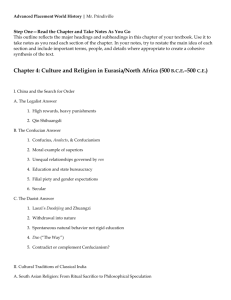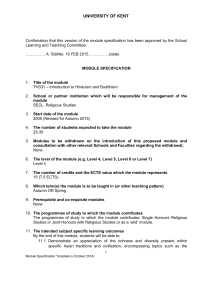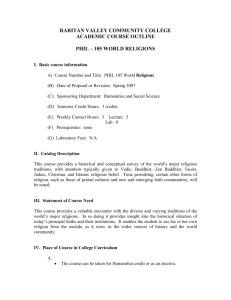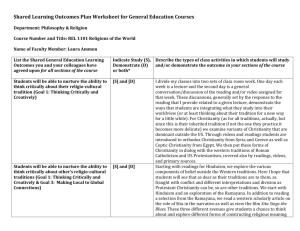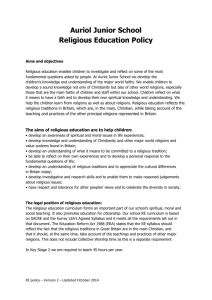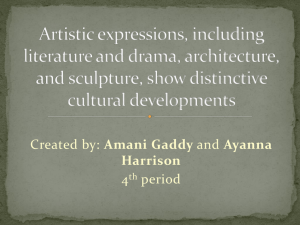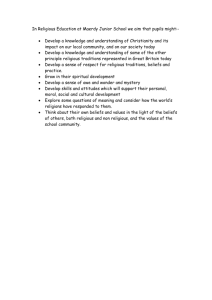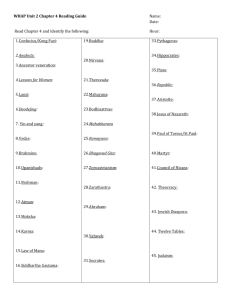America: A Concise History
advertisement
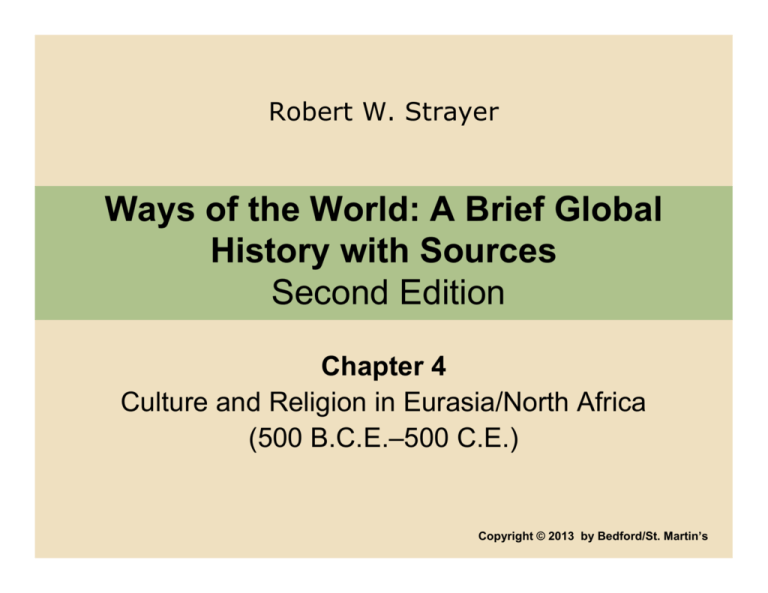
Robert W. Strayer Ways of the World: A Brief Global History with Sources Second Edition Chapter 4 Culture and Religion in Eurasia/North Africa (500 B.C.E.–500 C.E.) Copyright © 2013 by Bedford/St. Martin’s I. China and the Search for Order A. The Legalist Answer 1. High rewards, heavy punishments 2. Qin Shihuangdi I. China and the Search for Order B. The Confucian Answer 1. 2. 3. 4. 5. 6. Confucius, Analects, & Confucianism Moral example of superiors Unequal relationships governed by ren Education and state bureaucracy Filial piety and gender expectations Secular I. China and the Search for Order C. The Daoist Answer 1. 2. 3. 4. 5. Laozi’s Daodejing and Zhuangzi Withdrawal into nature Spontaneous natural behavior not rigid education Dao (“The Way”) Contradict or complement Confucianism? II. Cultural Traditions of Classical India A. South Asian Religion: From Ritual Sacrifice to Philosophical Speculation 1. Vedas (1500–600 B.C.E.), Brahmins, and rituals 2. Upanishads (800–400 B.C.E.) 3. Atman and Brahman II. Cultural Traditions of Classical India A. South Asian Religion: From Ritual Sacrifice to Philosophical Speculation 4. Samsara, moksha, and karma 5. Gender and the Laws of Manu 6. Cults and deities as different paths II. Cultural Traditions of Classical India B. The Buddhist Challenge 1. Siddhartha Gautama (ca. 566–ca. 486 B.C.E.) 2. The Buddha’s teachings and nirvana 3. Relationship to Hinduism II. Cultural Traditions of Classical India B. The Buddhist Challenge 4. 5. 6. 7. Restrictions and opportunities for women Popular appeal Theravada Mahayana’s bodhisattvas II. Cultural Traditions of Classical India C. Hinduism as a Religion of Duty and Devotion 1. Mahabharata, Bhagavad-Gita, and Ramayana 2. Bhakti 3. Buddhism absorbed back into Hinduism III. Toward Monotheism: The Search for God in the Middle East A. Zoroastrianism 1. Zarathustra (seventh to sixth century B.C.E.) 2. Persian state support, Achaemenid Dynasty (558–330 B.C.E.) 3. Ahura Mazda versus Angra Mainyu 4. Human free will, struggle of good versus evil, a savior, and judgment day III. Toward Monotheism: The Search for God in the Middle East B. Judaism 1. Migrations and exiles of a small Hebrew community 2. One exclusive and jealous god 3. Loyalty to Yahweh and obedience to his laws IV. The Cultural Tradition of Classical Greece: The Search for a Rational Order A. The Greek Way of Knowing 1. Questions, not answers 2. Socrates (469–399 B.C.E.), Plato (429–348 B.C.E.), and Aristotle (384–322 B.C.E.) 3. Rational and non-religious analysis of the world B. The Greek Legacy 1. Alexander the Great, Rome, and the Academy in Athens 2. The loss and recovery of Greece in Europe 3. Greek learning in the Islamic world V. The Birth of Christianity… with Buddhist Comparisons A. The Lives of the Founders 1. Encounter with a higher level of reality 2. Messages of love 3. Jesus’ miracles and dangerous social critique V. The Birth of Christianity… with Buddhist Comparisons B. The Spread of New Religions 1. 2. 3. 4. 5. New religions after their deaths Paul (10–65 C.E.) Lower social classes and women Non-European Christianity Christianity as a Roman religion V. The Birth of Christianity… with Buddhist Comparisons C. Institutions, Controversies, and Divisions 1. 2. 3. 4. 5. The exclusion of women from leadership Debates over doctrine and texts Council orthodoxy and expulsion Roman and Greek cultural traditions Diversity in the Buddhist world VI. Reflections: Religions and Historians A. B. C. D. Secular, evidence based history versus faith Change of time in the faith? Verifying the divine? Schisms within the faiths
